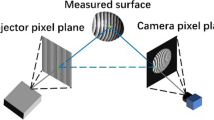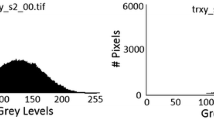Abstract
In this paper we investigate, determine and classify the critical configurations for solving structure and motion problems for 1D retina vision. We give a complete categorization of all ambiguous configurations for a 1D (calibrated or uncalibrated) perspective camera irrespective of the number of points and views. It is well-known that the calibrated and uncalibrated case are linked through the circular points. This link enables us to solve for both cases simultaneously. Another important tool is the duality in exchanging points and cameras and its corresponding Cremona transformation. These concepts are generalized to the 1D case and used for the investigation of ambiguous configurations. Several examples and illustrations are also provided to explain the results and to provide geometrical insight.
Similar content being viewed by others
References
M. Armstrong, A. Zisserman, and R. Hartley, “Self-calibration from image triplets,” in European Conf. Computer Vision, Cambridge, UK, 1996, pp. 3–16.
K. Åström, “Invariancy methods for points, curves and surfaces in computational vision,” Ph.D. Thesis, Department of Mathematics, Lund University, Sweden, 1996.
K. Åström, A. Heyden, F. Kahl, and M. Oskarsson, “Structure and motion from lines under affine projections,” in Int. Conf. Computer Vision, Kerkyra, Greece, 1999, pp. 285–292.
K. Åström and M. Oskarsson, “Solutions and ambiguities of the structure and motion problem for 1D retina vision,” Journal of Mathematical Imaging and Vision, Vol. 12, No. 2, pp. 121–135, 2000.
H.F. Baker, An Introduction to Plane Geometry, Cambridge University Press: Cambridge, UK, 1943.
T. Buchanan, “The twisted cubic and camera calibration,” Computer Vision, Graphics and Image Processing, Vol. 42, pp. 130-132, 1988.
S. Carlsson, “Duality of reconstruction and positioning from projective views,” in IEEEWorkshop on Representation ofVisual Scenes, Cambridge, MA, USA, 1995, pp. 85–92.
S. Carlsson and D. Weinshall, “Dual computation of projective shape and camera positions from multiple images,” Int. Journal Computer Vision, Vol. 27, No. 3, pp. 227–241, 1998.
O. Faugeras, Three-Dimensional Computer Vision, MIT Press: Cambridge, MA, 1993.
O.D. Faugeras, L. Quan, and P. Sturm, “Self-calibration of a 1D projective camera and its application to the self-calibration of a 2D projective camera,” in European Conf. Computer Vision, Freiburg, Germany, 1998, Vol. I, pp. 36–52.
R. Hartley, “Ambiguous configurations for 3-view projective reconstruction,” in European Conf. Computer Vision, Dublin, Ireland, 2000, Vol. I, pp. 922–935.
R. Hartley and G. Debunne, “Dualizing scene reconstruction algorithms,” in 3D Structure from Multiple Image of Large-Scale Environments, EuropeanWorkshop, SMILE, Freiburg, Germany, 1998, pp. 14–31.
R. Hartley and A. Zisserman, Multiple View Geometry in Computer Vision, Cambridge University Press: Cambridge, 2000.
B.K.P. Horn, “Motion fields are hardly ever ambiguous,” Int. Journal Computer Vision, Vol. 1, No. 3, pp. 239–258, 1987.
K. Hyyppä, “Optical navigation system using passive identical beacons,” in Proceedings Intelligent Autonomous Systems, Amsterdam, 1987, pp. 737–749.
F. Kahl, B. Triggs, and K. Åström, “Critical motions for autocalibration when some intrinsic parameters can vary,” Journal of Mathematical Imaging and Vision, Vol. 13, No. 2, pp. 131–146, 2000.
J. Krames, “Zur Ermittlung eines Objectes aus zwei Perspectiven (Ein Beitrag zur Theorie der gefährlichen Örter),” Monatsh. Math. Phys., Vol. 49, pp. 327–354, 1940.
S. Maybank, “The projective geometry of ambiguous surfaces,” Phil. Trans. Royal Soc. London A, Vol. 332, pp. 1–47, 1990.
S. Maybank, Theory of Reconstruction from Image Motion, Springer-Verlag: Berlin, 1993.
S. Maybank and A. Shashua, “Ambiguity in reconstruction from images of six points,” in Int. Conf. Computer Vision, Mumbai, India, 1998, pp. 703–708.
L. Quan, “Inherent two-way ambiguity in 2D projective reconstruction from three uncalibrated 1D images,” in Int. Conf. Computer Vision, Kerkyra, Greece, 1999, pp. 344–349.
L. Quan and T. Kanade, “Affine structure from line correspondences with uncalibrated affine cameras,” IEEE Trans. Pattern Analysis and Machine Intelligence, Vol. 19, No. 8, pp. 834–845, 1997.
H. Schröter, Theorie der Oberflächen zweiter Ordnung und der Raumkurve dritter Ordnung als Erzeugnisse projektvischer Gebilde, Teubner: Leibzig, 1880.
J.G. Semple and G.T. Kneebone, Algebraic Projective Geometry, Clarendon Press: Oxford, 1952.
J.G. Semple and L. Roth, Introduction to Algebraic Geometry, Clarendon Press: Oxford, 1949.
P. Sturm, “Critical motion sequences for monocular selfcalibration and uncalibrated Euclidean reconstruction,” in Conf. Computer Vision and Pattern Recognition, San Juan, Puerto Rico, 1997, pp. 1100–1105.
Author information
Authors and Affiliations
Rights and permissions
About this article
Cite this article
Åström, K., Kahl, F. Ambiguous Configurations for the 1D Structure and Motion Problem. Journal of Mathematical Imaging and Vision 18, 191–203 (2003). https://doi.org/10.1023/A:1022120702016
Issue Date:
DOI: https://doi.org/10.1023/A:1022120702016




